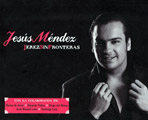RECORD REVIEW
|
Estela Zatania There used to be a time when you could say “cante”, and every flamenco fan knew what you were talking about. But times have changed, and now they tell us “cante” can be anything, that it’s nobody’s business to impose elitist definitions, much less tell a young singer what he can or can’t sing. Being open-minded, and not wanting to rain on anyone’s parade, I make an effort to apply the word to any number of items. The only problem is, then we have to grapple with the dilemma of what to call “cante”, and the solution is often as simple as just repeating the word. As in the hypothetical conversation I might have with young Jerez singer Jesús Méndez: Ladies and gentlemen, I am happy to report, if indeed anyone still hasn’t heard the news, that Jesús Méndez, from the noble lineage of his aunt Paquera, has made a recording of cante cante. Flamenco fans may breathe easy with relief, the honor of the San Miguel neighborhood is safe, and once again the big record companies are left scratching their collective head as they contemplate a small but faithful market that continues to demand straightforward flamenco, without extraneous trappings or superficiality. Guitar maestro Gerardo Núñez who includes Méndez in his performances, adds his touch in the bulerías that closes out the CD. The recording also enjoys the guarantee of the excellent guitars of Moraíto (listed here as Morao de Jerez), his son Diego, José Manuel León and Santiago Lara, a fine assortment of musicians for an interesting first record. Jesús came relatively late to cante. In one interview he mentions that he never sang at a fiesta – the place where singers perfect their art and acquire experience – until the age of sixteen. But he more than makes up for it with an excellent voice, and knowledge received from family members via oral transmission. The result is quite a respectable recording, based on the most classic sort of cante, spiced with contemporary details. The record opens with the only “concession”, a zambra of Antonio Gallardo, “Soleá de Mis Pesares”, sung por bulería with a slick delivery. We are quickly rescued by the inspired guitar of Moraíto to accompany the very Jerez-sounding soleá por bulería in which Méndez achieves some wonderful high points, ending with the Carapiera style so linked to the Agujetas and Moneos of San Miguel.
1. Soleá de mis pesares (zambra) |
Classic cante with contemporary details, and a fine voice
The Jerez style of singing usually treads too heavily to do justice to the delicate cantiñas that come from just a few kilometers away, but Jesús controls his angst to offer a perspective of his own, and José Manuel León’s accompaniment is crisp and upbeat.
Bulerías, the most relevant and dynamic cante of our era, the form that is reborn every day in a thousand voices, here finds an ideal vehicle in Méndez, once again with the guitar of Moraíto. In siguiriyas, with the accompaniment of Diego del Morao, not even the singer’s best efforts can dominate the contemporary guitar playing at high-speed which upstages the cante. Without guitar accompaniment those fast tempos don’t get in the way (remember Periñaca keeping compás with her cane at breakneck speed on Rito y Geografía del Cante), but when the guitar adopts the same velocity, the cante seems to become weightless and duende flies out the window.
In soleá, Jesús must again strive for the attention he deserves, and the lowered sixth string that Santiago Lara usually administers so discreetly, here seems overly insistent for my taste…you can’t overuse new toys or they break. In tonás, with classic styles and verses by David Lagos, Méndez lets flow the Antonio Mairena sound so much admired in the San Miguel neighborhood.
The CD winds up with bulerías a capella, a fashion that has almost become a tradition. Some musical phrases of Gerardo’s leave no doubt about his outstanding ability and serve to give a contemporary sound to the classic ambience.
An admirable piece of work Jesús has given us with his “cante cante”, a brave enterprise as we prepare to close out the first decade of the new millennium.
More information:
Jesús Mendez in DeFlamenco.com
